HOME PAGE
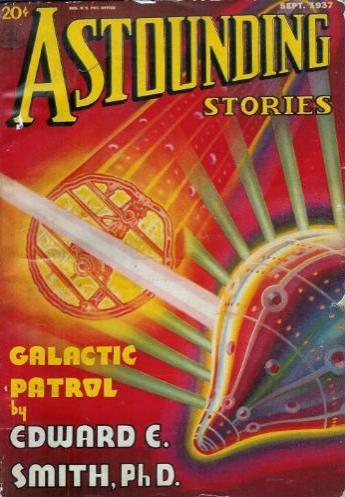
How the Intelligent Chip Works - The Definitive Explanation
Copyright © 2005 ... Geoff Kait, Machina Dynamica
UPDATED JUNE 2011
NOTE: This explanation applies to the original Intelligent Chip and
Machina Dynamica's new The Super Intelligent Chip
About the Author: Education: Aerospace Engineering (theoretical fluid dynamics, propulsion, statistical thermodynamics, nuclear physics, indeterminate structures). Undergrad thesis: Design of propulsion system for interplanetary travel utilizing momentum transfer mechanisms in highly magnetic metal crystal bombarded by high-energy ions. Work experience: NASA satellite operations & radar data analysis; aerodynamics of high-performance aircraft; reentry vehicle dynamics; radio and satellite communications; spread spectrum communications. He incorporated Machina Dynamica in 1998. He designed the Nimbus Sub-Hertz Platform, Promethean Base, Special Helical Springs, Brilliant Pebbles, The Super Intelligent Chip, the Clever Little Clock, Codename Turquoise II, Codename Top Banana II, Tru Tone Duplex Covers, Frog Jump in Water Sound Tweak, Codename White Poppy, Codename Blue Meanies, the Quantum Temple Bell, the Diamond Light Crystal, Flying Saucers for Windows, Flying Saucers for Wall Outlets, Sonic Tonic Anti-static Spray, Spectrum Purifier CD Coloring System, Blu Spectrum Blu Ray Coloring System, Dark Matter Optical CD Spray, Morphic Message Labels, Super Stiff Springs Mini Isolators and the Teleportation Tweak.

Uh, Leaking Quantum Material?
The original Intelligent Chip is a small orange plastic wafer the size of a camera's photo chip. When the Intelligent Chip is placed on top of a CD Player it automatically upgrades a CD (or any optical disc) when the CD is allowed to play for 1-2 seconds. The upgraded CD will lack the typical digital shrillness, hardness and thinness, be more correct-sounding and have considerably better inner detail and dynamics. In short, the CD will sound like a remastered version. The effects are permanent. The Intelligent Chip delivers a specific number of treatments, 10 for the GSIC-10 and 30 for the GSIC-30. If one attempts to treat a CD that's already been upgraded, the Intelligent Chip recognizes the CD has been upgraded and won't use up a treatment unnecessarily. In 2009 Machina Dynamica introduced The New Intelligent Chip, then The Super Intelligent Chip, incorporating the latest technological advancements, in June 2011. This paper applies to all versions of the Intelligent Chip.
When not in use, the Intelligent Chip is stored in its protective white plastic case (see photo below) to prevent light from striking it and reducing the number of treatments. They're hard to see but inside the protective case are two super-thin clear polycarbonate sheets that help shield the chip from light. The manufacturer states, "The Intelligent Chip should be put back into the packing case after using, because the packing case can protect the quantum material of the Intelligent Chip, preventing them from leaking."
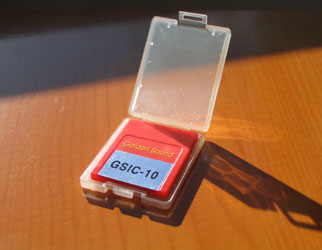 Photo by Machina Dynamica
Photo by Machina Dynamica
The Original Orange GSIC-10 Intelligent Chip in White Protective Case
Holding the GSIC-10 up to the light, is that some kind of electronic board inside, perhaps a tiny battery? Could the Intelligent Chip contain an RFID device capable of communicating with the compact disc in the player? If so, what kind of data on the CD would be altered? Is there control code on the CD, maybe timing information, that could change the sound? Can the data on the CD even be altered? Besides, how could any signal pass through the solid metal chassis?
Curiosity Killed the Cat - Inside the Intelligent Chip
Popping open the orange case of GSIC-10 with a razor blade reveals a thin emerald-green sheet embedded in the center of which is a tiny super-thin metal gold disc. What in the wide, wide world of sports is-a goin' on here??
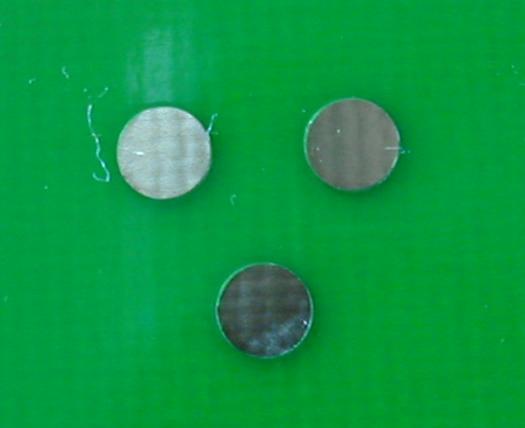 Photo Courtesy Audioannex.com
Photo Courtesy Audioannex.com
Inside the GSIC-30 Intelligent Chip:
Three Ultra-thin Silver Discs on Emerald Green Sheet
(Note Peculiar Irregular Quilted Surfaces)
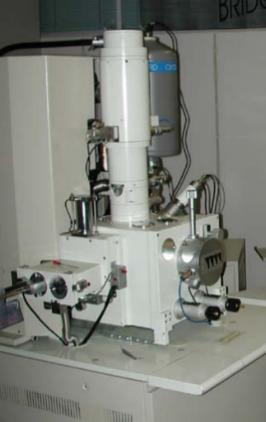
The Hunt for Artificial Atoms
Inside the GSIC-30 Intelligent Chip are 3 tiny silver discs embedded in a green plastic sheet (see photo above). One enterprising, skeptical customer went so far as to lug his GSIC-30 to a metallurgy lab to look for the alleged quantum material in the tiny silver discs with an electron microscope. The electron microscope did not find "artificial atoms" but it did identify Niobium (Nb) and Nickel (Ni) in the top surfaces of the metal discs and Copper (Cu), Zinc (Zn) and Aluminum (Al) in the bottom surfaces. The skeptical customer announced proudly, "No quantum material was found!" But what he and the folks at the lab didn't realize is that the "quantum material" is actually sandwiched between the metal layers and not visible to the microscope.
But the trip to the metallurgy lab was not in vain, at least as far as this little explanation is concerned, since the metals identified at the lab supports the notion that the tiny metal discs contain quantum dots or quantum dot arrays. Here's why: Due to their very high index of reflectivity for red & near infrared light, those metals (except Niobium) are commonly used for the metal layer of CDs. They're also used as cladding for quantum dot arrays to promote greater photoluminescence by trapping photons longer and extending the chain reaction of photons. Photons are absorbed & emitted via the edge of the quantum dot array.
So, what exactly are quantum dots and how could they possibly improve the sound of a CD? Quantum dots are "nanometer-scale" metal crystals originally developed in the 1980s for optoelectronic applications. The core of a quantum dot comprises only several hundred to several thousand atoms of a semiconductor material such as Cadmium Selenide (CdSe) or Indium Arsenide (InAs) in which "electron-hole pairs" can be created and confined. The quantum dot container (shell) is a different semiconductor material - say, Zinc Sulfide (ZnS) or Aluminum Gallium Arsenide (AlGaAs). Quantum dots & quantum dot arrays can be fabricated in the lab using many combinations of pure metals/metal alloys.
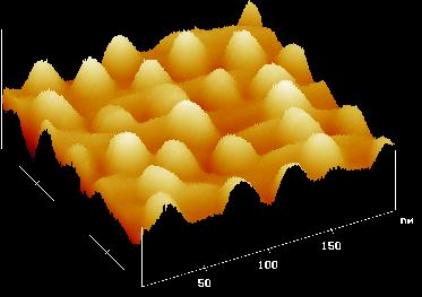 Courtesy Serguei A. Komarov, Stanford University
Courtesy Serguei A. Komarov, Stanford University
Self-organizing Quantum Dots Illustrating Electron Wave-functions

Electron Roach Motel
A semiconductor material that conducts with free electrons is called an N-type and one that conducts by virtue of electron deficiency is called a P-type. When an N-type layer is sandwiched between two P-type layers, a trap is created that attracts electrons into the N layer (like a magnet) and prevents them from escaping. Kind of an electron Roach Motel. Electrons check in - but they don't check out!
If the N layer can be made extremely thin - around 10 nanometers (50 atomic diameters) - the size of the trap approaches a quantum mechanical transition point called the de Broglie wavelength, beyond which electrons can no longer move as particles along the vertical axis of the trap - their positions & velocities behave probabilistically - i.e., they're forced to behave ONLY AS WAVES. This device with confinement in one dimension is called a Quantum Well and has the very useful property of radiating photons with precise wavelengths. The quantum well is used to produce laser beams for computers, fiber-optic networks, digital electronics, laser pointers and - more to the point - CD players.
A quantum wire is produced by cutting away most of the quantum well's top surface to obtain a thin "slice" of the top P layer and the N layer. A quantum wire confines the electron-hole pairs in 2 dimensions.
How to Make Artificial Atoms
Moving right along... chopping off both ends of the quantum wire produces a minuscule cube of material -- a QUANTUM DOT -- that confines the electrons in all 3 dimensions. The trapped electrons are forced to behave as de Broglie standing waves (clouds of electric charge) in all 3 directions. The negatively-charged electrons move as far apart from each other as possible - which is how electrons behave in a real atom. But there's no real nucleus in an electron-hole pair of the quantum dot -- the hole at center of the electron cloud that acts as the positively charged nucleus of the "artificial atom" is actually an empty space.
Quantum dots exhibit intense photoluminescence (emission of photons) when illuminated by laser light due to the very strong 3-D confinement of the electron-hole pairs. Quantum dots also respond to ordinary (non-coherent) sunlight & interior lighting, but to a lesser degree. The quantum dot core (metal "trap" for the electron-hole pairs) is usually contained inside a shell of semiconductor material with a higher energy state than the metal core, improving the degree of confinement of the electron-hole pairs and increasing photoluminescence intensity. The wavelength of radiated photons emitted by the quantum dot is a function of the diameter of the core -- the smaller the diameter the more the spectrum shifts toward blue and away from red. Thus, quantum dots can be designed to absorb and radiate photons at specific wavelengths or colors.
On Further Reflection
Quantum dots can be fabricated into arrays to increase their capacity & longevity - and to improve performance. Performance of the quantum dot array is maximized by lateral interdot excitation and by using highly reflective metals as "mirrors" to prolong and intensify the "photon chain reaction" (see next paragraph). Examples of highly reflective metals useful for this purpose are Al, Cu, Ni, Au and Zn. Photons are absorbed and emitted through the edge of the quantum dot array "sandwich." A quantum dot must contain a specific number of atoms in its core to emit photons with a desired wavelength; thus, the only way to increase the lifetime of the device (for a given wavelength) is to increase the number of quantum dots or quantum dot arrays. This is why the GSIC-10 Chip contains one tiny metal disc while the GSIC-30 contains three of them.
Chain Reaction
When the electron-hole pairs in the quantum dot core are excited by laser light they radiate photons (fluoresce). Energy is transferred between absorbed laser photons and the electron-hole pairs. Thermodynamic equilibrium is restored (as electron-hole pairs return to their ground states) via the emission of coherent light in a brilliant Photonic Bomb - analogous to the absorption and radiation of neutrons in an atomic bomb. Each photon absorbed by an electron-hole pair causes 2 more photons to be emitted, and so forth... all this in a blink of an eye, literally a chain reaction of photons. The ratio of the number of radiated photons to the number of absorbed photons is called the Quantum Yield; the more photons that are available to be absorbed the better. Highly reflective metals/alloys in the metal disc cladding improve confinement of the electron-hole pairs by momentarily delaying photon emission, boosting Quantum Yield.
Transparency of the Polycarbonate Layer
Coherent quantum superposition occurs when 2 coherent light fields simultaneously interact with matter to produce (in that matter) a much more optically transparent medium. Ordinary incoherent light vibrates in random, non-uniform directions over a range of frequencies whereas coherent light vibrates in one direction only, usually at a single frequency. When atoms of any type of matter absorb light energy, they transition from "ground" states to "excited" states. When the frequency of the coherent light matches the frequency of excitation of the atoms, it produces atomic resonance, greatly enhancing the response of the atoms. Light is absorbed and emitted as the atoms of the material fluoresce, signaling a return to their ground states.
If atoms of a material have lower energy states 1 and 2 to which they can drop from their excited state 3, it's possible to modify the propagation of light resonating with the 3 to 1 transition by applying a second "control" or "coupling" laser that resonates with the 3 to 2 transition. The combined light fields force all atoms in the material into a coherent quantum superposition of states 1 and 2, with a definite phase relationship between them. That means the atoms in the medium are in states 1 and 2 at the same time (like Schrödinger's cat). In this quantum superposition of the material, the two possible pathways along which light can be absorbed for the 1 to 3 transition and the 2 to 3 transition interfere and cancel each other, so that no light is absorbed. I.e., the atomic medium becomes almost totally transparent. With this new transparency comes higher optical signal to noise ratio (OSNR). The clear polycarbonate layer in commercial off-the-shelf CDs has a transparency of only around 92%.

A Fairly Significant Bump in the Road is Encountered
But, unfortunately, standard quantum theory says coherent quantum superposition disappears as soon as one or both of the light sources is turned off due to decoherence of the wave-function. So, unless there's some evidence that all or some quantum superposition effects are long-lasting we're stuck and can't use quantum superposition to explain how the Intelligent Chip works.
Fortunately for our theory, recent experiments (see Ref. 7) suggest that coherent quantum superposition is not nearly as short-lived as previously thought (see section below on Quantum Entanglement robustness and Altewischer's experiment). Even if quantum superposition turns out to be robust, some other problems must be solved: How can the CD laser light activate the quantum material in the chip when the laser and the chip are separated by the solid barrier of the CD player chassis? And how can the photons emitted by the chip interact with the CD laser light and CD inside the player?
Quantum Physics on a Macro Level
Standard quantum theory defines a Quantum System as a "superposition of states that is invariably and instantly destroyed by measurement of the system." This destruction of the Quantum System is referred to as the collapse of the wave-function of probability amplitudes that defines the system. The system ends up in a single, definite state. In the case of Schrödinger's Cat, the collapse of the wave-function when an observer intervenes results in the cat being found either definitely dead or definitely alive.
Schrödinger's Cat (translation of original text):
"One can even set up quite ridiculous cases. A cat is penned up in a steel chamber, along with the following diabolical device (which must be secured against direct interference by the cat): in a Geiger counter there is a tiny bit of radioactive substance, so small that perhaps in the course of one hour one of the atoms decays, but also, with equal probability, perhaps none; if it happens, the counter tube discharges and through a relay releases a hammer which shatters a small flask of hydrocyanic acid.
"If one has left this entire system to itself for an hour, one would say that the cat still lives if meanwhile no atom has decayed. The first atomic decay would have poisoned it. The Psi function for the entire system would express this by having in it the living and the dead cat (pardon the expression) mixed or smeared out in equal parts."
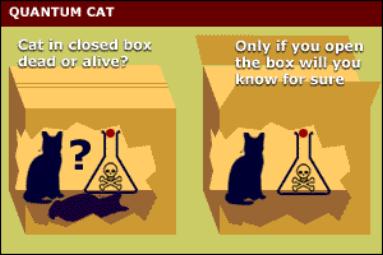
Schrodinger's Cat
I Tawt I Taw a Puddy Tat - Existing in Multiple States Simultaneously
Coherent quantum superposition and quantum entanglement are fundamental characteristics of a quantum system. Coherent quantum superposition refers to a quantum system's existing in multiple states simultaneously -- even states that are usually considered mutually exclusive - e.g., Schrödinger's Cat being both dead and alive at the same time. Quantum entanglement refers to what happens when particles/systems become correlated (interdependent) - no matter how far apart they are - such that the measurement of a property of one particle instantaneously determines that particular property of both particles.
Standard quantum theory says that this measurement of one particle collapses the wave-function of the 2-particle system. But is this interpretation overly simplistic? Could the "collapse of the wave-function" apply only to the measured property of the entangled state, while unmeasured properties remain indeterminate? For example, a measurement to determine if a particle is "spin up" or "spin down" leaves that particle and its entangled partner indeterminate as to whether their spins are oriented left or right. And if no measurement is made of any property of either particle, does the wave-function not collapse at all?

Those Rascally Altewischer Plasmons
Altewischer et al, Leiden University in the Netherlands, recently demonstrated that quantum entanglement between pairs of photons can survive even when one (or both) of the entangled photons is converted into a "surface plasmon," then reconverted back into a photon(s). Surface plasmons are oscillating electromagnetic fields strongly localized at the surface of a metal and are associated with the collective motion of a large number of electrons. Surface plasmons are formed on metal films perforated by an array of holes smaller than the wavelength of the photons. The plasmon tunnels through the holes to form a similar plasmon on the other side, where it eventually reverts back into a photon.
The state of a two-particle system is said to be "entangled" when two separate single-particle wave-functions cannot be factored out of its quantum-mechanical wave-function. Altewischer's team investigated what happens when entangled photons are sent through opaque metal films perforated with a periodic array of holes smaller than the wavelength of the photons. Will entangled photons survive and remain entangled? Surprise answer: Yes!
Altewischer's team launched photons of equal energy (wavelength) into a crystal, the properties of which caused each photon to split into 2 new photons; this process is called down-conversion -- each down-converted photon has double the wavelength and half the energy of the original photon. Spin and energy are conserved so the polarization (spin) of the two down-converted photons are always opposite in direction. If one down-converted photon is measured to be linearly polarized in the vertical direction, the other photon will always be linearly polarized in the horizontal direction -- as if the 2 photons are intimately connected, even when separated by great distance (non-locality).

Escape Artist
Back to the Intelligent Chip and our theory of operation. The theory thus far is that photons from two coherent light sources - the CD laser and the Intelligent Chip - combine to produce coherent quantum superposition in the atoms of the CD polycarbonate layer. But the $64,000 question is: How can the light from the two sources interact if they're separated by the solid metal chassis of the player? Remember, the chip is sitting on top of the player. The chassis of the CD player is much too thick for quantum tunneling to occur, so how can the CD laser light reach the Intelligent Chip in order to produce photoluminescence? AND how can the chip's emitted photons interact with the CD inside the player?
To answer those questions, consider that the CD player isn't really airtight or light-tight - it's actually a "leaky box" with many small openings and gaps in the chassis through which light can easily pass. The CD laser light reaches the Intelligent Chip by escaping through gap around the CD tray and filling up the room. The Intelligent Chip's photons reach the interior of the player the same way, through the gap around the CD tray.
Due to the "leakiness" of the CD player, the CD laser's light is scattered around inside the room -- red light (650 nm) for DVD/SACD players, near infrared light (780 nm) for CD players. CD Laser light escapes through the small holes & gaps in the player, instantly filling the room up with billions and billions of photons. A great many of the escaped photons are absorbed by room surfaces/carpet, but many photons survive and eventually strike the chip sitting on top of the CD player and cause the quantum material inside the quantum dots to fluoresce. (Note -- the chip's orange case is transparent to red and infrared light.) This all (including the light interaction with the CD) happens instantaneously as soon as the CD laser comes on since light travels at 300,000 km/sec. This theory that a sufficient number of laser photons survives to strike the chip is bolstered by the fact the CD laser's produces a hundred million billion (10 raised to the power of 17) photons per second. I.e., if only one millionth of the photons generated by the CD laser IN ONE SECOND escape the inside of the player and survive out in the room long enough to strike the Intelligent Chip, that number is still astronomical!
Light-Matter Interaction
The light-matter interaction can be simplified by making the room boundaries only a few inches from the CD player; then it's easier to visualize how the CD laser light escapes the inside of the player, reflects off room boundaries and finds its way to the chip, and how the entangled photons interact with the CD in the player. This simplification of light-matter interaction is illustrated in the figures below. As soon as the laser photons strike the quantum dots the dots fluoresce; the dots' emitted photons and the CD laser's photons immediately become entangled - both outside the player in the room and inside the player.
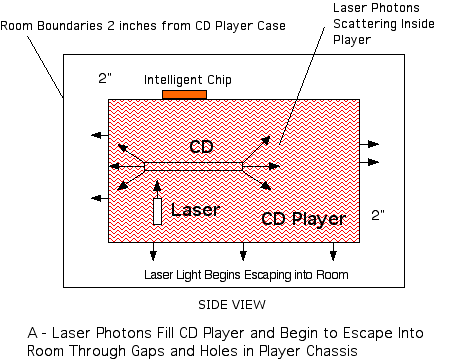
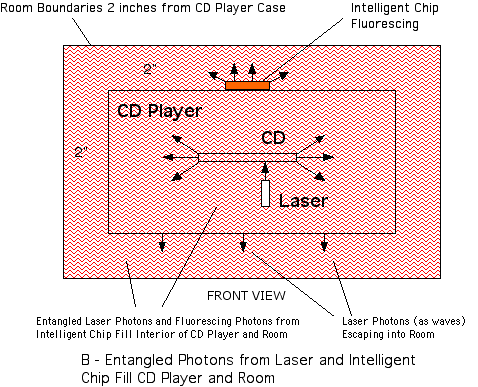
 ........
........
Kind of Blue
In case you were wondering about the orange case, it's transparent to infrared and red light just as an orange photographic filter allows infrared and red light to pass through. The Intelligent Chip loses effectiveness because of blue-shift in the emitted photon wavelength caused by "photobleaching" -- photo-induced ionization of many of the electron-hole pairs. At some point this blue shift nullifies the chip's ability to produce atomic resonance in the CD polycarbonate layer. But the artificial atoms are still alive and kicking, just at a difference wavelength.
Quantum dots also respond to the relevant wavelength of sunlight or indoor lighting, but not as strongly as they respond to (coherent) laser light. Storing the chip in its protective case helps protect it from the red/near infrared portion of sunlight & indoor lighting; the thin polycarbonate sheets inside the white protective case help block the IR spectrum (like clear polycarbonate lenses in reading glasses).
Epilogue: Think Inside the Box
The Super Intelligent Chip, designed and manufactured by Machina Dynamica, is considerably more powerful than the original Chip due to advancements in technology and method of use. The Super Intelligent Chip is a small 1/2" silver disc that is attached on the lower level of the CD tray used for Mini Discs or in the case of a tray without a Mini Disc area attached to the underside of the tray. Thus, the chip is inserted into the player along with the CD to be treated. The high laser photon density inside the player produces much greater photoluminescence in the chip! The Super Intelligent Chip treats 14 CDs, DVDs, SACDs or Blu Ray. The Super Intelligent Chip comes in an aluminum foil wrapper and due to its light sensitivity should always be stored in its wrapper when not in use.

Super Intelligent Chips
Summary
The Intelligent Chip works quantum mechanically via coherent quantum superposition and quantum entanglement. Two coherent light sources (the CD player laser and the quantum dots in the Intelligent Chip) interact with the atoms in the CD's polycarbonate layer to produce long-lasting, superior optical transparency for better optical signal to noise ratio during the laser-reading process. The active material in the Intelligent Chip is quantum dots - artificial atoms grown in the lab tuned to emit photons of a pre-determined wavelength.
In the case of the original Intelligent Chip, CD laser light escapes the player through a narrow gap around the CD tray. The emitted photons from chip commingle with the CD laser light that is everywhere in the room and inside the player; the commingled light resonates with the CD's polycarbonate material, improving its optical performance. In the case of The Super Intelligent Chip, the process occurs entirely inside the CD player where all the interactions are more intense.
Acknowledgements/References
1. Semiconductor Physics: Electrons in Artificial Atoms
2. Wired Magazine - Ultimate Alchemy
3. Interaction of Light with Matter
4. Coherent Quantum Superposition
5. How Not to Collapse the Wave-Function
6. Quantum Dot Lasers
7. Polycarbonate IR Filter Wavelength Region














 ........
........
